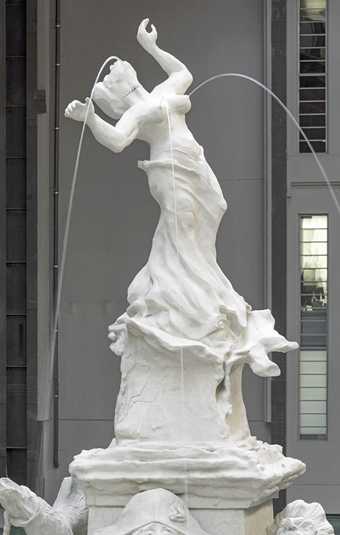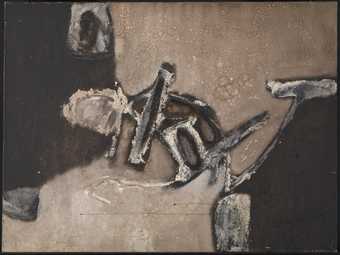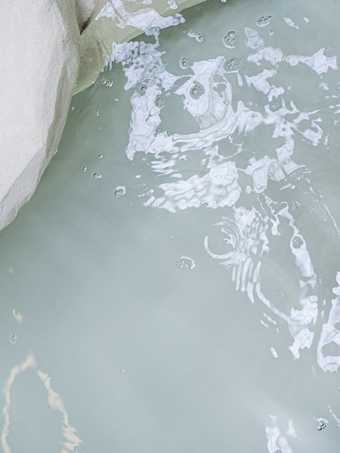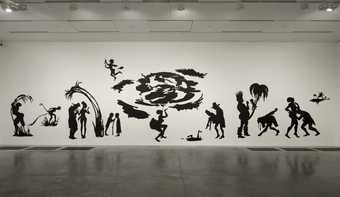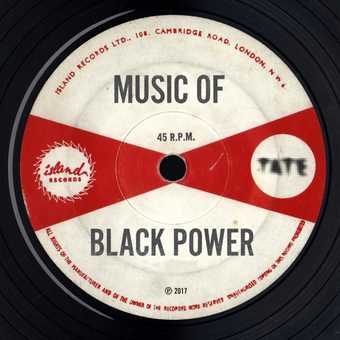Contents
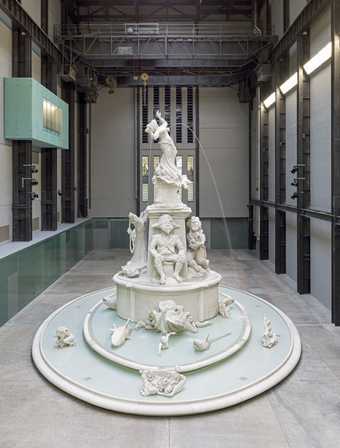
Kara Walker Fons Americanus ╔½┐ž┤½├Į 2019 (detail). Photo: ┬® TateŌĆŗ (Matt Greenwood)
Introduction
Kara Walker is an artist whose work explores ideas around identity, race, sexuality and violence. She works in a variety of mediums, including painting, print-making and installation. For ╔½┐ž┤½├ĮŌĆÖs 2019 Hyundai commission, Walker has created a large-scale public sculpture in the form of a four-tiered fountain. Fons Americanus questions how we remember history in our public monuments. At the same time, the work presents a narrative on the origins of the African diaspora.
Fons Americanus is inspired by the Victoria Memorial in front of Buckingham Palace, London. The memorial was designed in 1901 and unveiled in 1911 to honour the achievements of Queen Victoria who was the Queen of the United Kingdom of Great Britain and Ireland (1837ŌĆō1901), as well as the Empress of India. Rather than a celebration of the British Empire, ░┬▓╣▒¶░ņ▒░∙ŌĆÖs fountain inverts the usual function of a memorial and questions narratives of power. Walker explores the interconnected histories of Africa, America and Europe. She uses water as a key theme, referring to the transatlantic slave trade and the ambitions, fates and tragedies of people from these three continents. Bringing together fact, fantasy and fiction, Fons Americanus stands as a representation of this narrative in the form of an allegory or fable.
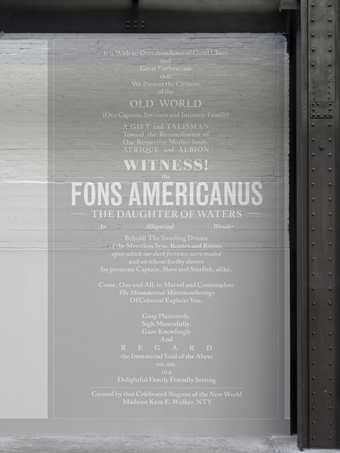
Kara Walker Fons Americanus ╔½┐ž┤½├Į 2019 (detail). Photo: ┬® TateŌĆŗ (Matt Greenwood)
The full title of the work is painted on the wall of the Turbine Hall. Written in ░┬▓╣▒¶░ņ▒░∙ŌĆÖs own words, the text encourages us to confront a history often misremembered in the UK. She presents the artwork as a ŌĆśgift ŌĆ” to the heart of an Empire that redirected the fates of the worldŌĆÖ. Walker has signed the work ŌĆśKara Walker, NTYŌĆÖ, or ŌĆśNot Titled YetŌĆÖ, in a play on British honours awards such as ŌĆśOBEŌĆÖ (Order of the British Empire).
Why a Monument?
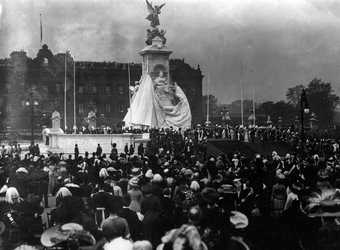
The Victoria Memorial outside Buckingham Palace, London being unveiled for the first time in 1911
░┬▓╣▒¶░ņ▒░∙ŌĆÖs choice to create Fons Americanus in the form of a public fountain is significant in the wake of recent student demonstrations to take down monuments that celebrate colonial histories in both the US and UK. Fons Americanus turns the celebration and honouring of monuments inside out. The monument asks uncomfortable questions by exploring a history of violence against Black people of Africa and its diaspora that is often unacknowledged.
As you enter the Turbine Hall, you first encounter a smaller monument of Shell Grotto. Taking the form of scalloped shells from art historical depictions of the Roman goddess Venus, ░┬▓╣▒¶░ņ▒░∙ŌĆÖs shell encases a weeping boy inside a well, almost completely submerged in water. His head floats just above the surface as if drowning or emerging from the depths, with pools of water running from his eyes.
░┬▓╣▒¶░ņ▒░∙ŌĆÖs Shell Grotto connects to the ruins of a colonial fortress on Bunce Island in Sierra Leone. Bunce Island was one of many commercial forts where European slave traders and African merchants traded and captured men, women and children ready for them to be sold on the plantations of the New World or America.
░┬▓╣▒¶░ņ▒░∙ŌĆÖs weeping boy and well question how these traumatic histories are now celebrated. The weeping boy bounces back from the depths of waters to interrogate what we choose to remember and what we forget. How can we see the monuments in our public spaces in a new light?
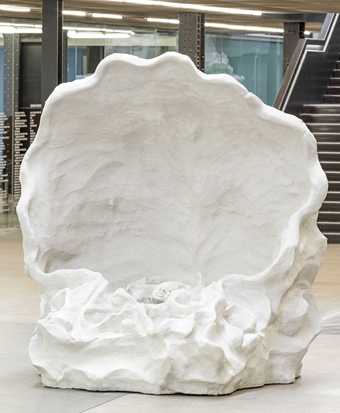
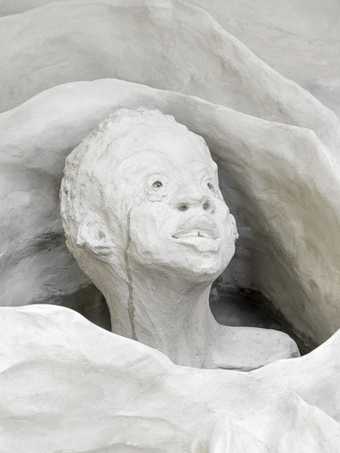
The Figures of the Black Atlantic
The larger fountain of Fons Americanus presents an allegory or extended metaphor of the Black Atlantic. The Black Atlantic is a term first used by the historian Paul Gilroy to acknowledge how the legacy of transatlantic slave trade has shaped the development of Black identity and culture in America and Europe.
Allegories often use caricatures or stereotypes to explore ideas and themes. Each figure is symbolic of an abstract concept, which in ░┬▓╣▒¶░ņ▒░∙ŌĆÖs case relates to the themes of her work. Walking around the fountain, you can see figures such as Venus, The Captain and Queen Vicky. These figures all symbolise different ideas around the transatalantic slave trade. They also reference an array of art historical, literary and cultural sources. Each element references imagery around the themes of violence and identity that Walker wishes to evoke or challenge. What do they remind you of?
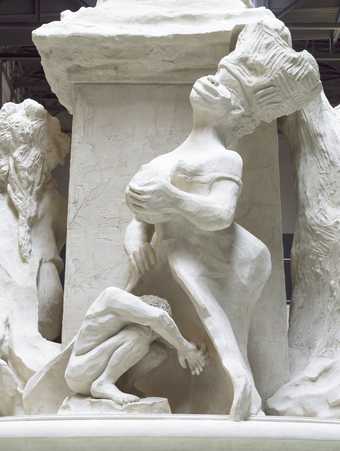
Queen Vicky
Kara Walker Fons Americanus ╔½┐ž┤½├Į 2019 (detail). Photo: ┬® Tate (Matt Greenwood)
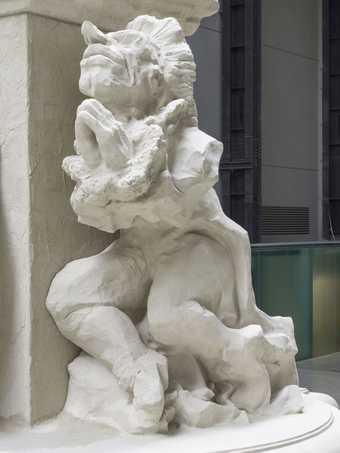
Kneeling Man
Kara Walker Fons Americanus ╔½┐ž┤½├Į 2019 (detail). Photo: ┬® Tate (Matt Greenwood)
On the second tier of her sculpture stands Queen Vicky. At the front of the memorial situated outside the gates of Buckingham Palace, Queen Victoria is sat regally on her throne looking out over the Mall. Walker plays with this image. Positioned at the back of the fountain, her queen is alive, joyful and caught mid-laughter. At her feet is a crouching personification of Melancholy, a human representation of deep sadness. His bowed head and crouched demeanour contrasts with the lively Queen Vicky who also holds a coconut at her breast, a symbol of life and sustenance.
On the same tier is a figure of a Kneeling Man. Walker suggests this may be a caricature of West Indies Governor Sir William Young. Young was an owner of sugar plantations and enslaved labourers in the Caribbean. Here the Kneeling Man is begging and is presented in a posture of remorse. A symbol of European colonialism, Walker has sculpted this man who once held so much power, in a vulnerable pose. Rebellions led by the enslaved threatened the economic strength of men like Young. Could he be kneeling in order to seek the mercy of the enslaved labourers? What else does his position suggest about the story Walker is telling?
The Significance of Water
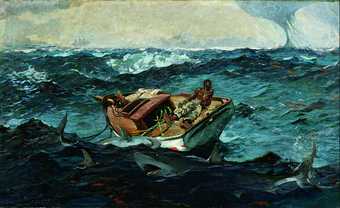
Winslow Homer, The Gulf Stream, 1899, Metropolitan Museum of Art, New York
The Atlantic Ocean connects Europe and America with Africa. It is on water that enslaved people were transported during the transatlantic slave trade without their consent to work for European and American plantation owners, a dangerous journey known as the Middle Passage.
In ░┬▓╣▒¶░ņ▒░∙ŌĆÖs sculpture, water is the source of power. On the lower basin of the fountain is the model of a fishing boat which has sprung a leak. As the water threatens to sink the boat, the seafarer inside becomes at risk. The scene references Winslow HomerŌĆÖs painting The Gulf Stream (1899) which depicts a Black sailor in a small rudderless boat with no sail. Sharks surround the boat symbolising the threat of imminent violence and danger.
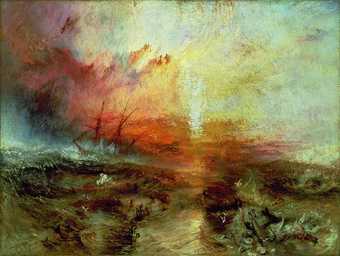
Joseph Mallord William Turner, Slave Ship, 1840, Museum of Fine Arts, Boston
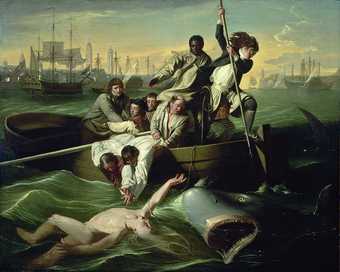
John Singleton Copley, Watson and the Shark, 1778, National Gallery of Art, USA
J. M. W. Turner's painting Slave Ship (1840) and John Singleton Copley's Watson and the Shark (1778) showing voyages around dangerous seas are also reference points here for Walker. Walker writes:
ŌĆśI looked at a grand panorama of a whaling voyage and considered the Black Atlantic as its been represented in art by Turner, Homer, Copley and sailors themselves ŌĆ” Drawing from and inverting the meanings and titles of famous (and not so famous) artworks and poetry from the colonial era to the present, my fountain yokes together racist representation and violent expression of power, issues which tend to become romanticized and often depicted in pastoral settings.ŌĆÖ - Kara Walker
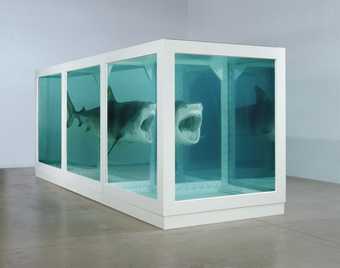
Sharks circle the boats and ships in ░┬▓╣▒¶░ņ▒░∙ŌĆÖs fountain too. She references Damien HirstŌĆÖs The Physical Impossibility of Death in the Mind of Someone Living (1991), as well as her own work in ░š▓╣│┘▒ŌĆÖs collection Grub for Sharks: A Concession to the Negro Populace (2004). HirstŌĆÖs artwork consists of a preserved tiger shark encased in a clear box of formaldehyde. Playing with the title, Walker has named this section of her fountain The Physical Impossibility of Blackness in the Mind of Someone White. She alludes to the catastrophe of the lives that were lost on the dangerous journeys made by the enslaved on the Middle Passage and the absence of their tragic stories from accounts and depictions of this history.
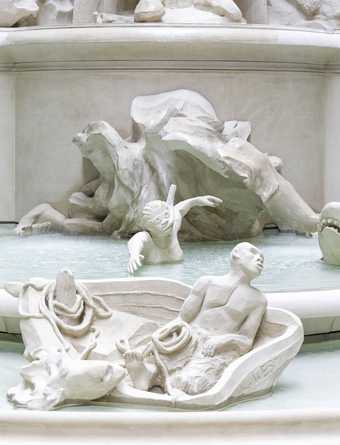
The Ship
Kara Walker Fons Americanus ╔½┐ž┤½├Į 2019 (detail). Photo: ┬® Tate (Matt Greenwood)
A Gift to the Empire
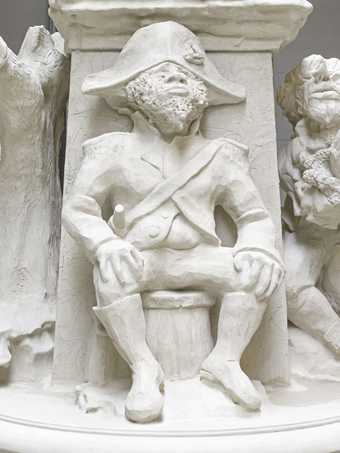
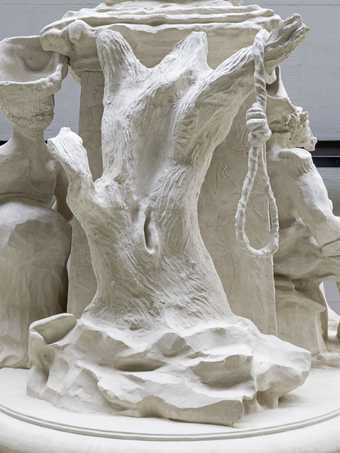
The Tree
Kara Walker Fons Americanus ╔½┐ž┤½├Į 2019 (detail). Photo: ┬® Tate (Matt Greenwood)
Walker describes her work as a gift ŌĆśfrom one cultural subject to the heart of an EmpireŌĆÖ. Although the British Empire ended in the late 1940s, the impact of its legacy still has meaning today. Sections of Fons Americanus appear to be moulded by hand out of clay, giving the impression the fountain has erupted from the floor of the tate Modern Turbine Hall. Situated in London, the city from which the British Empire was governed, ░┬▓╣▒¶░ņ▒░∙ŌĆÖs sculpture exposes the stories laying hidden in the elaborate symbolism of public monuments. It represents the violence and tragedy that have been erased from history.
One very direct example of this violence is Walker's sculpture of the tree with a noose hanging from a branch. It evokes images of the frequent lynchings of African-Americans by white supremacists, who were rising in number following the end of the American Civil War and the emancipation of enslaved peoples in the late 19th Century. It is important to take a moment and think about the significance of this image. What feelings do you have when you see it?
░┬▓╣▒¶░ņ▒░∙ŌĆÖs figure of The Captain takes position at the front of the sculpture. The Captain is a composite of important Black individuals who rebelled against European colonial forces. These include figures such as Fran├¦ois-Dominique Toussaint LŌĆÖOuverture (1743ŌĆō1803) and Marcus Garvey (1887-1940). LŌĆÖOuverture was the leader of the Haitian Revolution who instigated a slave revolt that led to the abolishment of slavery and the founding of the sovereign state of Haiti. Jamaican-born nationalist and leader of the pan-Africanism movement in America, Marcus Garvey authored The Declaration of Rights of the Negro Peoples of the World (1920) and advocated for the establishment of independent Black states around the world. ░┬▓╣▒¶░ņ▒░∙ŌĆÖs The Captain is a combination of these real-life heroes with fictional characters that represent for her the desire and will to fight against European colonialism.
Changing the Narrative
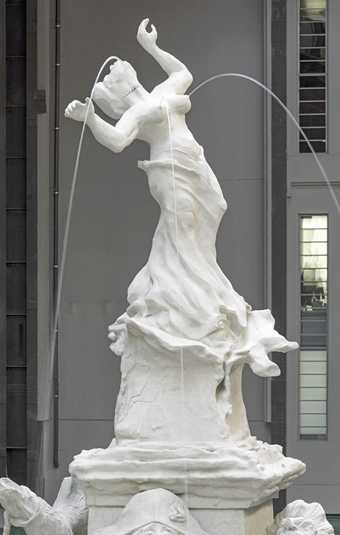
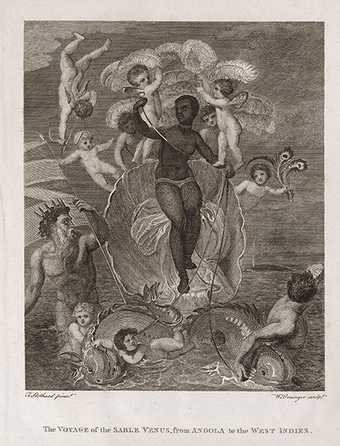
Thomas Stothard, The Voyage of the Sable Venus from Angola to the West Indies (1801) National Maritime Museum, Greenwich
░┬▓╣▒¶░ņ▒░∙ŌĆÖs work confronts the way we look at history of slavery, the violence inflicted on Black bodies and the endurance of racist imagery. At the very top of her fountain stands the figure of Venus. Various references of this deity go as far back as Roman mythology, and more recently to the 19th century engraving The Voyage of the Sable Venus from Angola to the West Indies by British artist and book illustrator Thomas Stothard (1755ŌĆō1834). Originally published in the 1801 edition of the book History, Civil and Commercial, of the British Colonies in the West Indies, it portrays Venus as an African woman who stands on an opened half-shell, surrounded by white cherubs. Accompanying her is Triton, the Greek god and messenger of the sea, who carries the British flag triumphantly and guides the procession across the waters. The image was used as a form of propaganda to promote the transatlantic slave trade.
Walker reclaims the image of Venus. Her version stands majestically at the summit of the fountain and spouts water at the final point of the waterŌĆÖs journey becoming the Daughter of Waters. She is no longer the Venus we see in StothardŌĆÖs image, but rather is resurrected as a priestess of Afro-Brazilian or Afro-Caribbean religion who takes her rightful place as the final voice in the story.
'The amniotic fluid at the beginning of this journey is now transformed into motherŌĆÖs milk and lifeblood. Mother, whet nurse, whore, saint, Host, loverŌĆöshe is the daughter of waters.' ŌĆō Kara Walker

